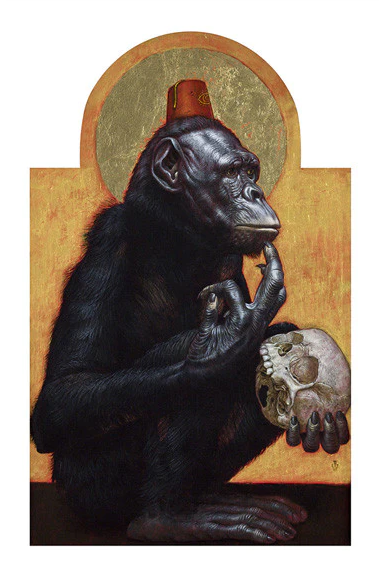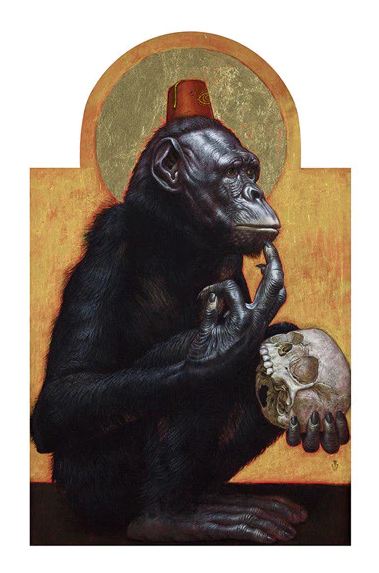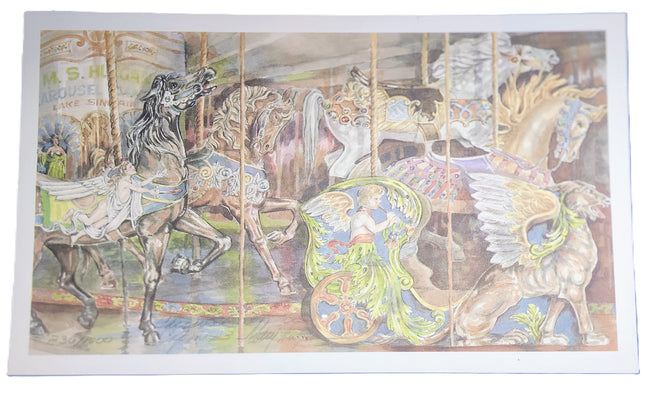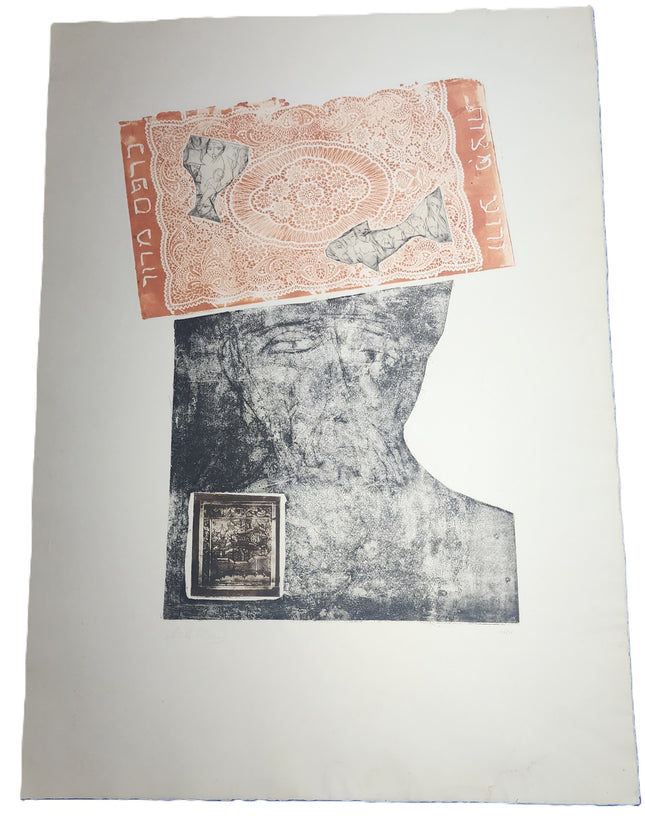
Contemporary Modernism & Vintage

Turf One- Jean LaBourdette The Artist' Unconscious Mind(Self-Portrait Giclee Print by Turf One- Jean LaBourdette
The Artist's Unconscious Mind(Self-Portrait Digital Ultrachrome Giclee Print by Turf One- Jean LaBourdette Artwork Limited Edition Print on Photo Rag Hahnemühle Fine Art Paper Graffiti Pop Street Artist. 2010 Signed & Numbered Limited Edition of 50 Artwork Size 16x24 The Artist's Unconscious Mind: A Glimpse into Turf One's Psyche "The Artist's Unconscious Mind (Self-Portrait)" is a digital ultra-chrome giclée print by Jean LaBourdette, known in the art world as Turf One. This limited edition print, released in 2010 with only 50 signed and numbered copies, is a quintessential example of his foray into street pop art and graffiti artwork. The artwork size of 16x24 inches, printed on Photo Rag Hahnemühle fine art paper, is a testament to Turf One's commitment to quality and his respect for the craft of fine art printing. Symbolism and Technique in Turf One's Giclée Print The piece stands out for its symbolic complexity and meticulous detail, common threads in Turf One's artwork. The choice of a chimpanzee wearing a fez and contemplating a human skull is evocative of the classical theme of 'vanitas,' touching upon the transient nature of life and the pursuit of knowledge. This recurring motif in art history, most famously depicted in Holbein's "The Ambassadors," is given new life and meaning in Turf One's contemporary interpretation. The use of ultra-chrome, a modern printing technique known for its color accuracy and longevity, bridges the gap between traditional fine art mediums and the digital age. This method allows the depth and nuance of Turf One's original paintings to be captured with high fidelity, making the prints true to the artist's vision. Intersecting Street Art and Traditional Imagery Turf One's work often intersects the gritty reality of street art with the intricate and symbolic nature of traditional imagery. "The Artist's Unconscious Mind" is no exception. It offers a commentary on the artist's internal dialogue and the intersection of animalistic instincts with the intellectual pursuit of self-awareness. By juxtaposing the primitive with the enlightened, Turf One presents a tableau ripe for interpretation and reflection. The fez, often associated with Eastern mysticism and philosophy, suggests a connection between wisdom and the primal aspects of our nature. The chimpanzee's human-like pose and contemplative gaze bring forth a sense of kinship with the animal kingdom, a subtle nod to the evolutionary aspects of human consciousness and artistry. The Influence of Street Pop Art on Turf One's Expression In "The Artist's Unconscious Mind," Turf One incorporates the immediacy and rawness often associated with street pop art and graffiti artwork. The fine art paper chosen for the print adds a tactile quality that echoes the texture of walls that serve as canvases in the street art world. Even as a print, the artwork carries the weight and presence of a piece that could adorn an urban landscape, bringing the reflective nature of fine art to the public sphere. Turf One's approach to street art is not about vandalism or territory marking but a deeper exploration of personal and collective identity. His work transcends the typical boundaries of street art, challenging viewers to consider the profound questions of existence and self, all while maintaining a connection to the urban roots of his medium. Collectibility and Impact of Turf One's Limited Edition Prints The collectibility of "The Artist's Unconscious Mind" is heightened by its limited run, making each print a coveted piece for collectors and admirers of Turf One's work. The scarcity of the prints ensures that each piece remains a treasured artifact of the artist's exploration into the depths of the unconscious mind. Like many limited editions, this artwork is more than just a representation of Turf One's artistic talent; it is a vessel for the ideas and themes that permeate his body of work. The print is a physical manifestation of the dialogue between the artist and the audience, a dialogue that continues evolving with each viewing. Reflecting on Turf One's Artistic Journey "The Artist's Unconscious Mind (Self-Portrait)" encapsulates Turf One's journey through street pop art and fine art printing. The print is a mirror reflecting the dual nature of the artist's world - one foot in the raw, expressive world of graffiti and the other in the contemplative, reflective world of fine art. This piece is a testament to the enduring power of art to convey complex ideas and emotions, regardless of the medium. As such, it is a significant work within Turf One's oeuvre, embodying the essence of his artistic spirit and the transformative potential of street pop art.
$400.00

Other Artists Carousal Capers 3 Lithograph Print by Mary Hulgan
Carousal Capers 3 Lithograph Print by Mary Hulgan Hand-Pulled Print on Fine Art Paper Limited Edition Graffiti Street Pop Artwork. 1985 Signed & Numbered Limited Edition of 1000 Artwork Size 16x9.5 Depicting Various Horse in a Vintage Style Carousal. Mary Hulgan's "Carousal Capers 3": A Dance of Color and Nostalgia "Carousel Capers 3," a lithograph print by Mary Hulgan, is a vivid expression of movement, color, and vintage charm, rendered with the careful touch of an artist deeply attuned to the nuances of visual storytelling. Signed and numbered in a limited edition of 1000, this 1985 artwork, measuring 16x9.5 inches, captures the whimsical essence of carousel horses in a style that resonates with the playful and evocative spirit of street pop art and graffiti. The Vintage Carousel: An Emblem of Pop Artistry Carousels, with their ornate designs and historical significance, have long been a subject of fascination in the arts. Hulgan's portrayal of these majestic creatures in "Carousal Capers 3" is a homage to the golden age of amusement, where the carousel symbolized joy, nostalgia, and the circular dance of life. The piece radiates a sense of timelessness, akin to the enduring nature of street art that captures the essence of cultural moments and preserves them on city walls and canvases. The lithograph's vintage aesthetic and Hulgan's choice of a warm color palette impart a sense of history reminiscent of how street art often incorporates elements of the past to create new narratives. Each horse's distinct adornments and poised stance tell a silent story, inviting viewers to engage with the artwork's inherent sense of play and fantasy. Reflections of Street Art in Lithographic Expression While "Carousal Capers 3" may initially seem distant from the grit of graffiti and the pop of street art, a closer look reveals a shared lineage. Lithography, much like street art, is a democratic art form, allowing for the reproduction and dissemination of works to a broad audience. Hulgan's lithograph, with its careful layering of inks and hand-pulled technique, shares the meticulous craftsmanship and bold visual impact of the best street murals. Furthermore, the carousel's embodiment of communal memory and shared public space echoes the collective experience of street art, where images become part of the communal consciousness. Hulgan's work celebrates this shared visual heritage, encapsulating the joy and artistry of a bygone era while speaking to contemporary tastes and sensibilities. Mary Hulgan's "Carousal Capers 3" stands as a testament to the power of printmaking in capturing the spirit of an era and the joy of simple pleasures. With its limited edition status, the artwork becomes an accessible treasure, a piece of historical trance that can be owned and cherished. It is a reminder that art, like a carousel, is cyclical, ever-turning, and always returning to the hearts of those who cherish its beauty and wonder.
$125.00

Zwy Milshtein Three-Piece Etching Aquatint Print by Zwy Milshtein
Three-Piece Etching Limited Edition Etching with Aquatint Print on Hand-Decorated Fine Art Paper by Zwy Milshtein is a pop art graffiti artist art. 1970 Signed & Numbered Limited Edition Etching Art Print. Artist: Zwy Milshtein Title: Three Piece Etching Medium: etching, with Aquatint Size: 21 x 30 inches Edition: Signed in pencil and marked 26/75 Zwy Milshtein: A Maestro of Etching and Aquatint Zwy Milshtein's artistic narrative is one of movement, not just across geographies but also through the evolution of his distinct style and technique. Born in 1934 in Kichinev, now known as Moldova, Milshtein's journey through the turbulence of World War II led him from Russia to Romania and eventually to Israel. However, in Paris, to which he moved in 1955, Milshtein found his enduring artistic home. Here, he became renowned as both a painter and a master engraver, celebrated for his etchings and engravings that capture the complexity of human experience. The Intertwining Paths of Engraving and Street Art The "Three-Piece Etching" by Milshtein is a testament to the craftsmanship and depth of engraving as an art form. Completed in 1970, this signed and numbered limited edition etching with aquatint, measuring 21 x 30 inches, is a fine example of Milshtein's adeptness with aquatint—a technique that allows for the creation of tonal effects, producing rich textures and a range of shades that lend a painterly quality to prints. This artwork, part of an exclusive series marked 26/75, is particularly notable for its abstract composition and the intriguing use of negative space, which engages the viewer in a visual dialogue reminiscent of contemporary street art and graffiti. Milshtein's Impact on Contemporary Art Milshtein's influence on the art world is well-documented through numerous exhibitions and retrospectives. His work was featured at ARC, the Museum of Modern Art in Paris, and in 1978, the Bibliotheque Nationale in Paris hosted a retrospective exhibition of his engravings. His artistic achievements include participation in the Hans Christian Andersen House project 1997, where he, along with other top European artists, paid tribute to the Danish author's bicentennial birthday. The aesthetic choices and technical skill displayed in works like "Three-Piece Etching" echo the visual strategies found in street pop art and graffiti. Milshtein's art, while distinct in its medium and execution, shares the spirit of innovation and subversion that is a hallmark of street art. His engravings invite the public to explore themes of identity, memory, and existence, much like street art and graffiti often do within the urban landscape. Zwy Milshtein's contributions to the world of engraving and his explorations in aquatint have secured his reputation as an artist of great skill and depth. "Three-Piece Etching" is a prime example of his ability to communicate complex ideas through printmaking. His legacy continues to inspire and influence artists within and beyond pop art, street art, and graffiti, affirming his artistry's enduring power and relevance.
$350.00




